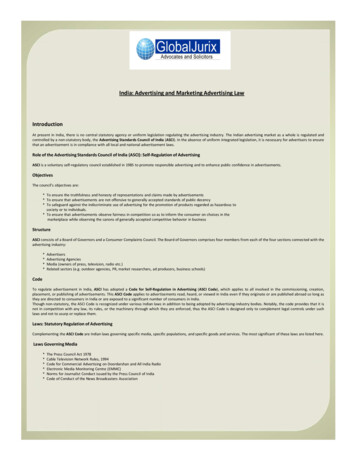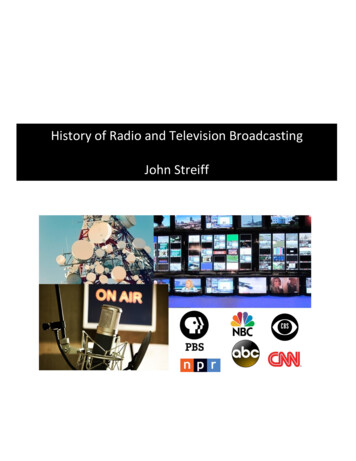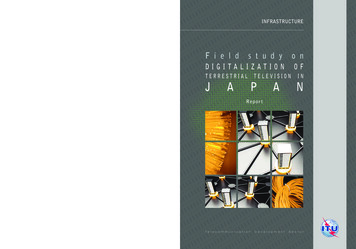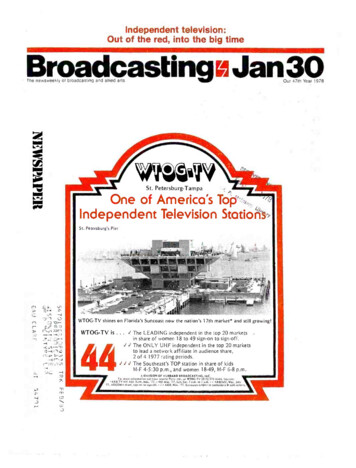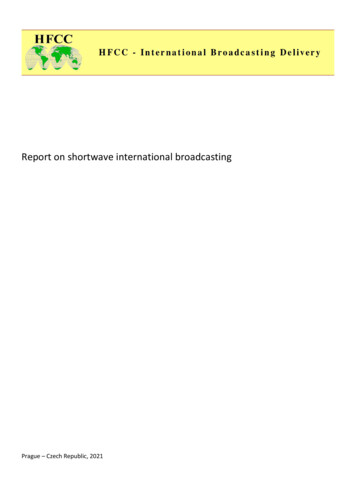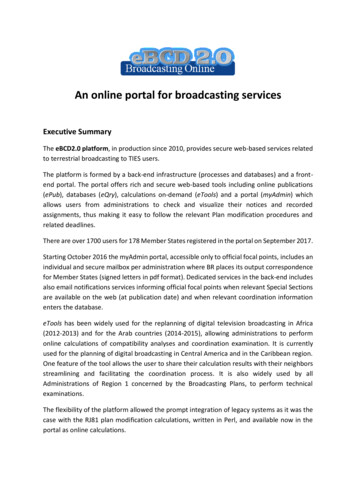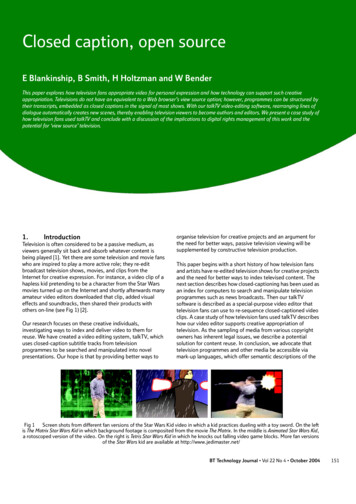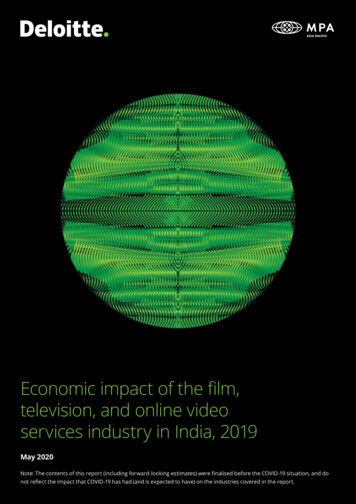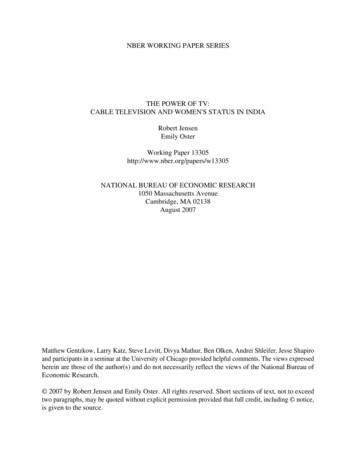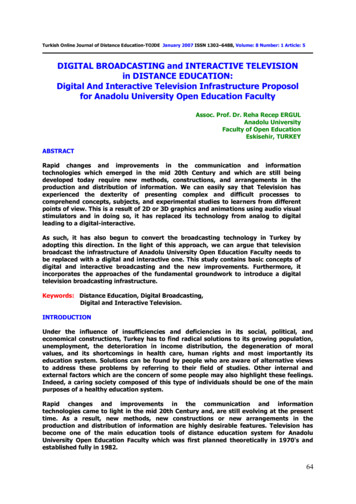
Transcription
Turkish Online Journal of Distance Education-TOJDE January 2007 ISSN 1302–6488, Volume: 8 Number: 1 Article: 5DIGITAL BROADCASTING and INTERACTIVE TELEVISIONin DISTANCE EDUCATION:Digital And Interactive Television Infrastructure Proposolfor Anadolu University Open Education FacultyAssoc. Prof. Dr. Reha Recep ERGULAnadolu UniversityFaculty of Open EducationEskisehir, TURKEYABSTRACTRapid changes and improvements in the communication and informationtechnologies which emerged in the mid 20th Century and which are still beingdeveloped today require new methods, constructions, and arrangements in theproduction and distribution of information. We can easily say that Television hasexperienced the dexterity of presenting complex and difficult processes tocomprehend concepts, subjects, and experimental studies to learners from differentpoints of view. This is a result of 2D or 3D graphics and animations using audio visualstimulators and in doing so, it has replaced its technology from analog to digitalleading to a digital-interactive.As such, it has also begun to convert the broadcasting technology in Turkey byadopting this direction. In the light of this approach, we can argue that televisionbroadcast the infrastructure of Anadolu University Open Education Faculty needs tobe replaced with a digital and interactive one. This study contains basic concepts ofdigital and interactive broadcasting and the new improvements. Furthermore, itincorporates the approaches of the fundamental groundwork to introduce a digitaltelevision broadcasting infrastructure.Keywords: Distance Education, Digital Broadcasting,Digital and Interactive Television.INTRODUCTIONUnder the influence of insufficiencies and deficiencies in its social, political, andeconomical constructions, Turkey has to find radical solutions to its growing population,unemployment, the deterioration in income distribution, the degeneration of moralvalues, and its shortcomings in health care, human rights and most importantly itseducation system. Solutions can be found by people who are aware of alternative viewsto address these problems by referring to their field of studies. Other internal andexternal factors which are the concern of some people may also highlight these feelings.Indeed, a caring society composed of this type of individuals should be one of the mainpurposes of a healthy education system.Rapid changes and improvements in the communication and informationtechnologies came to light in the mid 20th Century and, are still evolving at the presenttime. As a result, new methods, new constructions or new arrangements in theproduction and distribution of information are highly desirable features. Television hasbecome one of the main education tools of distance education system for AnadoluUniversity Open Education Faculty which was first planned theoretically in 1970's andestablished fully in 1982.64
The appeal of this mass-communication device suits the needs of the large number ofregistered students at this institution and its affordable feature has helped in the process.Distance education system has also been backed up by teleconferencing, computer aidedor web based education, in line with the developments in printed materials, academiccounseling, and technological developments.Television has shown its dexterity of presenting complex and difficult process tocomprehend concepts, subjects, and experimental studies to learners fromdifferent points of view. This is supported by photographs, 2 D or 3 D graphics andanimations with audio visual stimulators. As a result TV technology has evolved from ananalog to digital one, resulting into a digital-interactive medium. By embracing thisapplication, Turkey has witnessed an advancement towards this direction. The Turkishprivate television company, Digiturk, has begun broadcasting digitally and it is nowtransmitting its broadcasts to receivers through satellites. During the "EuropeanBroadcasting Union (EBU) Technical Committee Annual Meeting" in 2004, the statetelevision broadcast channel TRT announced that it would change its television broadcastsystem to digital within a transition period of 10 years (Tew, 2006). Since AnadoluUniversity Open Education Faculty television programs are broadcast through TRT,educative television program production studios of Anadolu University are expected todevelop their current technological infrastructure to be fully prepared for digitalbroadcasting.Establishing the infrastructure required for digital television broadcasting in distanceeducation is the first step. This would hopefully make interactive broadcast easier. Forsuch an innovative infrastructure to be rewarding, preparations of the sole AnadoluUniversity television program production center are not enough. That is to say that sincethis institution is not legally the main provider Anadolu University has to cooperate withbroadcaster and service provider organizations and institutions like TRT and TurkTelekom.WHY DIGITAL?The first binary number which is the origin of modern digital systems and composed of"0"s and "1"s was devised by philosopher and mathematician Gottfried Wilhelm vonLeibnitz on March 15, 1679 (Pohlmann, 1995:7). However, digital encoding language isbased on the Morse code. Every letter and symbol in the Morse code has a code similar tothe binary number system. Radio and television have developed through the years withsimilar technological infrastructures until 1990's when computer technology had reachedan acceptable scale capable of processing audio and video. After, these technologicaldevelopments began to plan a common language or system. The basis of digital systemsis formed by data encoding systems which are based on "0's and 1's" pronoun as “bits”and used by computer technologies. These are accepted as the common language. In thisway, television entered into the digital communication world.When the initial low data processing rates and limited data storage capacities, notforgetting the huge size of data required for images are take into consideration, thedifficulties of digital systems in providing necessary bandwidths for broadcast can bebetter understood. Naturally, improving data processing rates, the capacities ofcomputers, plus software have accelerated the digital technologies appearance into everyaspect of life as well as in broadcasting. When digital broadcasting technology iscompared with analog technology, its advantages can be summarized as follows:¾¾¾¾¾Better quality audio and video broadcastMore channels and higher capacityCapability to correct data errors which may happen during broadcastDecrease in generation loss due to data copyingCompatible and cooperative with other transmitting environments likethe Internet65
¾ Easy access to audio and video data, editing and archiving¾ Provision of mutual data transfer or briefly interactivityThe most important benefit of digital television broadcasting is in its power to steer awaytelevision from being a unidirectional passive watching device and lead it into theinteractive communication world of bidirectional data transfers. Digital televisionbroadcast, namely Digital Video Broadcasting (DVB) is seen as the future of broadcastingand its standards are determined as being statutory, and legal by InternationalTelecommunication Union and European Broadcasting Union.DIGITAL TELEVISION (DTV) or DIGITAL VIDEO BROADCASTING (DVB)During the development process of mass-communication technologies beginning from1990’s up to now, there have been many changes. The Internet and mobilecommunications technologies have provided users with the interactive digital services.Television has followed this trend through a digitizing process. Digital television is a“hybrid” platform combining classical analog TV and Internet or similar platforms withdata provided by multimedia services. Digital television is a revolutionary technology inbroadcasting and can be considered as a gate way to an interactive media world.The first technical stage of digital broadcasting is to convert video signal that changesbetween 25 and 30 frames per second according to broadcasting standards into digitalsignal encoded as 1 and 0 bits. In other words, images like the ones as shown in Figure 1,are divided into the smallest parts or points called “pixels”. Color and brightness of eachof these pixels are defined to achieve a digitizing process.Figure: 1Digital video compression (Pagani, 2003:55)66
For example, in an image frame with broadcast quality, there are 720 points horizontallyand 576 points vertically that total 414.720. If a broadcast quality of 25 frames persecond is assumed, point number defined by 1 byte reaches to 10.368.000. In short, adigital video image of 1 second contains information of 10 million points (Durmaz,1999:3). In order to broadcast digital audio and video carrying such a large amount ofinformation, a very large bandwidth is required. This is a significant point fortransmission lines with limited bandwidth. Therefore, in order to solve this problem,compression techniques are used.DIGITAL COMPRESSIONBecause of limited data storage and transmitting capacity in the main production andtransmission processes like digital signal or processing, storing, archiving andbroadcasting of data, digital compression methods are needed.Large amounts of bandwidth may be required for example 64 Kbps for audio and 12 Mbpsfor video. Compressing of digitized signal allows transmitting more channels withinnarrower bandwidths. However, broadcasting compressed data and then restoring themto their original condition in receiver devices requires the above standard.The basic technology for realizing digitalization in broadcast services is the MPEG-2(Moving Picture Experts Group) standard. MPEG–2 defines the basic concepts for theprovision of digital A/V services in all the digital television standardization efforts. MPEG2 defines a signal compression, packetization and multiplexing standard for digital audioand video, as well as rudimentary mechanisms for conveying other data in a digital A/Vstream. Transport stream (TS) and program stream (PS) definitions have a specific set ofapplication areas. The most important application area of the TS is digital television. Thebasic packet-oriented multiplexing approach for video, audio and other data defined inMPEG-2 is illustrated in Figure 2. Digital video and audio data is encoded into compressedMPEG-2 video and audio elemantary streams. These elemantary streams are packetizedto produce video and audio packetized elemantary steams (PES) packets. Private data isfed directly to the PES packetizer. PES packet streams are multiplexed to single transportor program streams depending on the application. The program stream is designed foruse in relatively error-free environments such as DVDs (Lugmayr & other, 2004.11).MPEG-2 standard is used successfully at bit rates exceeding 1 Mbps but this would notsuffice in the future. Although MPEG-4 format conceptually has common properties withMPEG-2, it has optimized video and audio compression algorithms. There is noincompatibility between MPEG–2 and MPEG-4: MPEG-2 decoders installed in receiversand PC’s are also used decoding MPEG-4 streams.The ability of MPEG–4 to dissect the image, or even synthesise a part of it electronicallyinto different constituent planes, lies in its hard. It will allow non-real cartoon like imagesto be merged with normal real-world image, and at the decoder several planes can becombined, either under direct control of programme maker, or by the viewer, or both.The artistic potential for new kinds of programmes is immense. In order for the system tosupport the new complexities, one of the essential parts of MPEG–4 is a labelling schemewhereby the image planes and contents, especially the objects in each plane, can beidentified to machine processes as well as by the viewers.This implies some kind of description language and data formats that serve to define theimage content. This so-called Metadata is what MPEG–7 emphasises with the intent ofproviding tolls for the system and operators to describe the content and its properties(Drury, 2000.37).67
VideoDataVideoEncoderAudioDataAudioEncoderPrivate acketizerPE/PSDataPESMPEG-2 Systems LevelFigure: 2MPEG-2 video, audio and data multiplex (Lugmayr & other, 2004:11).MPEG-4 format allows possibilities for new applications and services on the Internetrather than digital television broadcasting. Applications with MPEG-21 format are rathernew and works on compatibility with other formats are still in progress. Video, audio andother data digitalized during the first stage of digital television process are compressedand packetized with reduced bandwidth and then sent via transmission lines using one ofthe three methods: Terrestrial (DVB-T), Satellite (DVB-S), and Cable (DVB-C). In additionto these, digital television signal can be transmitted via other transmission media such asMultipoint Microwave Distribution System (MMDS) and Asymmetric Digital SubscriberLine (ADSL).DIGITAL TRANSMISSION SYSTEMSIn DVB-T, DVB-S, DVB-C and other transmission systems data are transmitted in twoways. The first is via cable using traditional copper coaxial or optic fiber cables; and thesecond is wireless via airwaves or satellite. Data transmitting rates, capacities, coverage,service lives and costs are different from each other. Transmission systems can be usedfor transmitting digital television data together or separately.Digital transmission is thetransmission of analog or digital data in the form of digital signals. Digital transmissionspeed is usually measured in bits per seconds or symbols per second, either one referredto as data rate. The data rate can be either in bits per seconds (bps) or in bauds (orsimply baud rate). Baud rate is defined as the number of symbols per second. Data rate inbits per second is also called the bit rate (Ahmad, 2002: 65).Table: 1Digital television and transmission lines bit rates.Digital TVDigital HDTVADSL (High speed modem)6-10 Mbps5.1 Audio40-60 Mbps5.1 Audio uncompressed1-2 MbpsTelephone modem14-56 KbpsISDN64-128 KbpsInternet2 (US)9.6 Gbps68
Bit rates of data to be transferred through digital transmission systems determine thecapacity of a system. Examples of bit rates used in digital television or transmission linesare shown with Table: 1.DVB-T (Terrestrial) has 7-8 MHz bandwidth and uses MPEG-2format. It enables broadcasting more channels via low powered terrestrial transmittersusing VHF and UHF bands. DVB-S (Satellite) transmits data directly or indirectly throughsatellite using MPEG-2 compression format on 11-12 GHz Ku band. DVB-C (Cable)transmits a multitude of channels to viewers through satellite compatible cable and itsmost important feature is that it has interactive broadcasting infrastructure. AsymmetricDigital Subscriber Line (ADSL) technique is a readily available solution for the supply ofinteractive multimedia services because it makes use of the pre-existing telephonenetwork.This technology will be used in the medium term to extend the supply of multimediaservices to those areas not yet included in the new broadband infrastructure still underconstruction. In some areas, where territorial morphology and population density makeneither cabling nor the implementation of a radio system economically viable, ADSLbecomes the first choice. It is difficult, however, for ADSL to be used on a vast scalebecause of its limited growth potential in performance terms and the high number ofapparatus necessary for each user connected to the service. ADSL is a selective system: itallows for the use of one or two quality video programs at a time chosen from muchbroader bouquet, therefore limiting the possibilty of contemporary use from two or moreterminals connected to the same line (Pagani, 2003:79).When assessed according to different configurations, capacities, data transmitting ratesand costs, each digital system defines a convenient transmission line for itself. Dependingon the data transmitting purpose of the digital system, they can be used together orseparately. When Anadolu University Open Education and its considerable studentpopulation together with geographic conditions are taken into account, it would be verydesirable that DVB-S and DVB-T transmission systems should be used together for digitaland interactive television broadcasting. DVB-C and ADSL transmission systems areeconomical for densely populated areas like cities, but they are not suitable transmissionsystems for less populated areas like the top-boxADSLModemGSM etc.Figure 3Internet protocol TV (IDTV) transmissions channels (Orava & Perttula, 2004: 7)69
INTERACTIVE TELEVISION (ITV)The term interactivity is usually taken to mean the chance for interactive communicationamong subjects. Technically, interactivity implies the precence of a return channel incommunication system, going from the user to the source of information. The channel is avehicle for the data bytes that represent the choices or reaction of the user. Thisdefinition classifies systems according to whether they are diffusive or interactive.Diffusive systems are those where only one channel runs from the information source tothe user (referred to as downstream). Interactive systems have a return channel from theuser to the information source (referred to as upstream).There are two fundemental factors determining performance in terms of systeminteractivity. These are response time and return channel band (Pagani, 2003: 97).Thegreatest advantage of digital video broadcasting (DVB) is interactivity. The convergenceof broadcasting and internet technology brought about two way communications.Interactivity can be provided by return channel and a passive user becomes an activeuser. Return channel (as a back channel) is a kind of feedback from viewer tobroadcaster. In this way, digital television system becomes a powerful medium forcommunication (Kesim, 2005: 3). In the interactive television system shown in Figure 4,transport streams containing the video-audio content prepared by Anadolu UniversityOpen Education Faculty in standard MPEG-2 format are transmitted to service providervia satellite. Service provider transmits these data streams to students through terrestrialand cable lines. If the lecture is broadcasted live, students can transmit their responsesto the studio via feedback channel through multimedia home platform (MHP), set-topbox, and PC etc. Here, the central components are the DVB broadcasting service providerand the interactive service provider.DVB Service Provider(DVB-S, DVB-T, DVB-C, hannel)Anadolu Uni. OpenEdu. Fac.Tv. Production CenterInternetLearner ReceiverPlatform(Tv, Digital Tv, Pc,Set-top-box, MHP,.)Figure 4Interactive television (ITV) system architecture.Digital video broadcasting is an extension of MPEG-2 based DVB transmission standards.This extension provides ways to transport data other than standard MPEG-2 A/V data inDVB broadcast systems. Examples of data broadcasting include the download of softwareor the delivery of Internet services over broadcast link.70
The DVB feedback channel allows the upsteams flow of data from the user to theinteractive service provider. The network independent protocol accesible in the feedbackchannel are either IP-based, MPEG-2 DSM-CC based or service specific. Networkindependent protocols in a broadcast channel for interactive services rely on the DVBdata broadcasting standards (Lugmayr & other, 2004:15). Bit rates of MPEG-2 formattransmitted to students are between 4-9 Mbps.This indicates that digital television can transmit better quality video, audio, and 2 D or 3D graphics than the traditional television format. When bidirectional communication isalso added to the above quality, it is seen that digital and interactive television is animportant communication device that should be utilized in distance education system.CONCLUSIONTelevision programs are defined as being one of the essential components of AnadoluUniversity Open Education system (Bozkaya, 2006:146), and in order to enhance theirviewability and student achievement an interactive structure is needed. Because of thegreat student number, television as a mass communication device plays an important rolein this process. Therefore, the first and the easiest phase in establishing an interactivetelevision system for distance education is migrating to digital television.Digital television is not just compressed video-audio and optimized image quality.Distance education offers the opportunity for repeating television programs and receivingstudent feedback whenever and wherever needed. With the aid of increased audio visualquality, digital and interactive television can help presenting subjects intelligibly andmore in detail by removing the restrictions of traditional television system that has aunidirectional communication.In e-learning distance education system, television programs can be transmittedinteractively via high-speed Internet and ADSL. If e-learning teaching materials consistof high resolution 2 and 3 dimensional graphics, pictures or video, using datacommunication on the Internet will not be adequate. Establishing an ADSL infrastructurein the countryside is also costly and difficult. It is getting harder for many users utilizingthe Internet environment simultaneously for the purpose of learning because of thenarrow bandwidth. For this reason, a convergence can be obtained between the twosystems by using the digital video broadcast or digital transmission lines and high-speedInternet simultaneously. Compression methods, transmission systems and feedbackchannel play an important role within digital process. MPEG-2 format and its even moreextended standards are applied by the interactive service providers successfully.However, the important issue here is that Anadolu University Open Education system hasnot the right to broadcast television programs legally. Hence, establishing a digital andinteractive television infrastructure for distance education requires at first to establish atechnical work group to liaise with the broadcasting organization TRT.BIODATA AND CONTACT ADDRESSES OF AUTHORDr. Reha Recep Ergül is an Assoc. Prof. in Anadolu UniversityOEF-TV Production Center, Turkey. He received his PhD fromAnadolu University Institute of Social Sciences Cinema andTelevision Department in 1994. He has been teaching digitaland analog recording techniques of film and television soundin Anadolu University Communication Sciences Faculty since1994. The author is currently a faculty member of AnadoluUniversity OEF. His research fields are new communicationtechnologies.71
Assoc. Prof. Dr. Reha Recep ERGULAnadolu Üniversitesi, Açıköğretim FakültesiYunusemre Kampusü, 26470, EskişehirPhone: 90 0222 335 05 80 (ext. 2437)E-mail: rrergul@anadolu.edu.trREFERENCESAhmad, A. (2002). Data Communication Principles for Fixed and Wireless Networks.Secaunus, NJ, USA: Kluwer Academic Publishers.Bozkaya, M. (2006).Use of Television in Distance Education. Journal of SelçukCommunication, 3, pp. 146–158.Drury, G. (2000). Coding and Modulation for Digital Television. Hingham, MA, USA:Kluwr Academic Publisher.Durmaz, A. (1999). Digital Televizyonun Temelleri (Essentials of Digital Television).ESBAV Yay., Eskişehir, Turkey.Kesim, M. (2005). E-Learning Via Cooperative Use of DVB and High Speed Internet:Convergence of Broadcasting and internet. Lifelong E-Learning. EDEN 2005 AnnualConference, Helsinki, Finland,Lugmayr, A. , Niianen, S. and Kalli, S. (2004). Digital Interactive TV and Metadata. NewYork: Springer-Verlag.Orava, J. and Perttula, M. (2004). Interactive digital TV in Europe. E- Content Report–7ACTeN. Retrieved June 2004, from: www.acten.net.Pagani, M. (2003). Multimedia and Interactive TV: Managing Opportunities Created byDigital Convergenge. Hersey, PA, USA: Idea Group Inc.Pohlmann, K, C. (1995) Principles of Digital Audio. USA: McGraw-Hill, Inc.Tew, B. (2006). DTT Trial in Turkey Begins. Retrieved 7 th February 2006, from:http://www.digitv-tr.org.72
The first binary number which is the origin of modern digital systems and composed of "0"s and "1"s was devised by philosopher and mathematician Gottfried Wilhelm von Leibnitz on March 15, 1679 (Pohlmann, 1995:7). However, digital encoding language is based on the Morse code. Every letter and symbol in the Morse code has a code similar to
